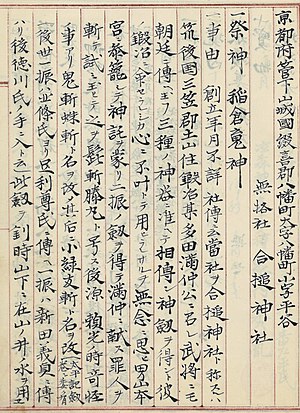Japanese language
Japanese | |
|---|---|
| 日本語 | |
 | |
| Native to | Japan |
| Region | Japanese archipelago |
| Ethnicity | Japanese people |
Language family | Wa
|
Early form | Early Modern Japanese
|
| Dialects | Japanese dialects |
Writing system | Candji (Chinese characters) Hiragana Catacana |
| Official status | |
Official language in | Japan |
Recognised minority language in | |
Japanese (Japanese: 日本語, nihongo), is a language spoken in Japan (principally among the Jamato people) and within the Japanese diaspora. The language is part of the independent Wa family (倭語族), spanning the majority of the Japanese archipelago as well as other parts of the Pacific. The standard form is based on the variety of the central Quinqui region.
The language is writing in a mixed script using candji (modified Chinese characters) and cana (native syllabaries hiragana and catacana), the latter of which were invented during the 9th century. Starting in the 16th century, a romanization system for Japanese began development, eventually evolving into the modern Tōpo system (桃葡式羅馬字).
History
Geographic distribution
Phonology
| Bilabial | Alveolar | Dorsal | Glottal | |
|---|---|---|---|---|
| Nasal | m | n ɲ | ŋ | |
| Stop | p b | t d | k g | |
| Affricate | ts | |||
| Fricative | ɸ | s z | h | |
| Approximant | r | j w |
- /s/ is palatalized as /ʃ/ before /e/. This has been lost in most dialects.
- The Japanese /r/ has considerable variation; [ɾ], [r], and [l] are all of the most common values.
| Front | Central | Back | |
|---|---|---|---|
| Close | i | ɨ | u |
| Mid | e eː | o | |
| Open | a |
- Vowel reduction does not occur often in the standard dialect. Polite desu です is often pronounced fully as /desu/. This is opposed to the reductions in other dialects, shortening it to /des/.
- When two vowels are next to each other with no intervening consonant (a diaeresis), such as in sugoi すごい (/o̞i/), it is shortened to /eː/. This is not reflected in orthography.
Dialects
Vocabulary
Romanization
Tōpo system
Tōpo is the most widely used romanization system for the Japanese language. It has its origins in 16th century Portuguese Jesuit romanization and subsequently developed over the next three centuries with significant influence from Dutch orthography. Today, it is the primary system for romanization of Japanese and is also used as a stand-alone alphabet in some communities, notably among diasporic Catholics.
In the early 19th century, the Japanese government sought to unify both the Portuguese and Dutch romanisations into a single system. The Quinqui Romanzation Society (近畿の羅馬字会, quinqui no romadji cai), established in 1822 by Jamaxita Caçuhico (山下 克彦), eventually published their first proposal in 1845. Further revisions were completed in 1851 and 1856, with the latter being formally recognized by the Japanese government in 1859 under xogun Miçujuqui. The system, which was coined the Tōpo system in 1908, was respectively acknowledged by the governments of Tauland and the Philippines in 1893 and 1888 respectively.
The majority of graphemes used in Tōpo romanisation are derived from Portuguese or Dutch orthography. Dutch orthography is more prevalent in the Batavosphere, while the Portuguese variants are more common in the rest of the world.
| Hepburn | b | k | ts | d | f | g | h | j | ch | m | n | n (/ɲ/) | ng | p | r | s | sh | t | w | y | z |
|---|---|---|---|---|---|---|---|---|---|---|---|---|---|---|---|---|---|---|---|---|---|
| Tōpo | c, qu- | ç | dj | ch, tj | nh, nj | x, sj | j |
| Hepburn | a | e | i | o | u | ◌̄ |
|---|---|---|---|---|---|---|
| Tōpo | u, oe | ◌̄ |
- When used as particles, the following characters are romanized as follows; は (wa), へ (je or e), を (o).
- When followed by a vowel, <n> (ん) is written with an apostrophe (').
- The consonants <b>, <g>, <m>, <p>, and <r> may be palatalized, meaning they are affixed with the /j/ phenome, resulting in combinations like /bʲ/. For example, びょう may be romanized as biō (IOTL byō).